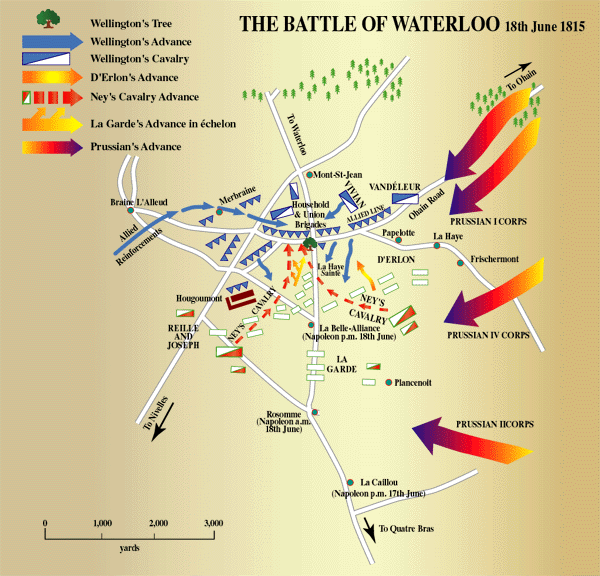

(Wellington to the Prince Regent, Waterloo Dispatch, Dispatches XII, 484)
On February 26th 1815, barely ten months after the end of the Peninsular War, Napoleon sailed from Elba to bring about the end of his brief period of exile. It was the beginning of the final, momentous chapter of the Napoleonic Wars that would culminate in the great battle of Waterloo and Napoleon's final downfall. The campaign was also to result in a head to head between the two greatest commanders of that age, two men who until now had never ever faced each other on the killing grounds - Wellington and Napoleon!
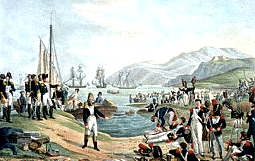 |
(Napoleon landing at Golfe Juan 1st March 1815)
While Wellington replaced Robert Lord Castlreagh at the Vienna Congress and his Paris embassy was guarded by young Lord Fitzroy Somerset and his charming wife Lady Burgersh, Napoleon had landed in France almost unnoticed on the 1sr of March 1815 . Only a bare three weeks later he entered Paris on March 20th to the acclamation of a populace in folly and carried on the shoulders of his officers.
He immediately set to work, nominating a new government for his country, announcing a Champs de May to swear his oath to the constitution and tame the reticence of the legislators and peers against a new dictatorship and………….. raising an army, the so-called Army of the North which, by the time of the Waterloo campaign consisted of 125,000 men.
Facing the Emperor were the armies of the Seventh Coalition,which numbered theoretically as many as 800,000 men. At Vienna the delegates of the Congress unanimously had declared Napoleon an enemy and the ‚Disturber of the Yorld‘.
Of the various armies opposed to Napoleon it would be only the Anglo-Dutch army, under Wellington, and Marshal Blucher's Army of the Lower Rhine that would be the object of Napoleon's thrust in June 1815. The Austrians were still heavily engaged against Murat in Italy and the troops of the Czar were on the march from their faraway country to the west of Europe. They could not be accounted for before the late Autumn and the end of campaign season!
Wellington's Anglo-Dutch army was a marked contrast to that which had triumphed in the Peninsula only a short ten months earlier: The government of England, disturbed by thoughts of a second Marlborough rising his sword and claim to power had dispersed Arthur‘s wonderful force and scattered it pitilessly around the world and mainly to that hopeless war in America. Only a handful of his Peninsular veterans would stand by the Duke on Flander‘s Fields!
Many of these regiments were already in Holland having served with Sir Thomas Graham's force which had taken part in the short campaign against Bergen-op-Zoom in 1813 and 1814. In fact, only 34,000 of the 100,000 troops under Wellington were British, the rest being Germans, Hanoverians and Brunswickers, all good troops, and also a large contingent of Nassauers, Dutch and Belgians, not worse then the others but until recently used to fight for the Eagle of France and still shaky in their love for the newly established Kingdom of the Lower Countries under the House of Orange.
It was, as Wellington was moved to write, `an infamous army, very weak and ill-equipped.' Apart this, his army spoke six different languages and several dialects and had ugly problems of communication. His staff was very inexperienced, although he did have several experienced men who had fought with him through the Peninsula: Hill, Picton, von Alten, Kempt, Pack and Somerset.
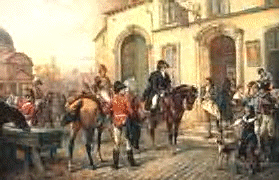 |
The Morning of the Battle-Wellington in Front of the Inn at Waterloo
(Painting by R.Hillingford)
He also had the services of the best of the British cavallery commanders, Henry Paget the Earl of Uxbridge. Uxbridge had once eloped with Wellington‘s sister-in-law , the wife of his brother Henry and then already mother of four.This incident had followed the La Corunna campaign of 1808-09 and although Arthur himself did not mind („He will not run away with me!") , Henry Paget due to social restrictions and the code of honour of this time saw no further service in Portugal or Spain: As a result of this the British cavalry in the Peninsula was deprived of the only real cavalry commander the British Army possessed. Nevertheless, old differences having been settled by a divorce and a remarriage ( and Wellington himself adopting a poor baby born in the time when Charlotte Wellesley had not known to well with whom to stay, neither Henry Paget nor Henry Wellesley would admit being the babe‘s father!) Uxbridge was to lead the cavalry with distinction during the Waterloo campaign.
On June 15th 1815 Napoleon's army crossed the Sambre, catching Wellington - so goes the legend dear to Peter Hofschroer and some others - who was dancing the night away with his officers at the now-famous ball, given by the Duchess of Richmond at Rue de la Blanchisserie, by surprise. For the moment let us stick to this lore, which we well put under scrutiny a bit later on not to interupt the flow of the story!
For reasons of basic logistics and to keep open communication lines with the ports on the Dutch coast, Arthur‘s army had concentrated to the south of Brussels, while Prince Blucher's Prussians extended on the Belgian capital‘s left. Napoleon's plan was to drive a wedge between the two forces and fight each army separately. It was vital, therefore, to prevent co-operation between the two and on June 16th and the two battles designed to ensure this were fought. At Ligny, Napoleon himself attacked Blucher and gave him a severe mauling, but could not prevent the Prussians‘ orderly and controlled retreat towards Wavre. Michel Ney, with about 42,000 men, attacked and advanced post and later Wellington at the crossroads at Les Quatre Bras.
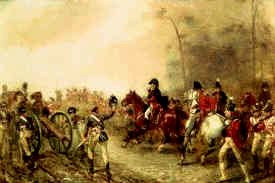 |
Wellington on the Road to Quatre-Bras
(Painting by R.Hillingford)
The end result of a day of hard, confused fighting was that Blucher, having lost about 12.000 men had been forced to retreat north and in turn forced Wellington, who had blooded Ney to withdraw through rain and thunder in the same direction, marching parallel with the Prussians and keeping in close contact with them throughout.
By the evening of June 17th Wellington had drawn his army up along a ridge barring the road to Brussels, just south of the village of Mont St Jean. The position was a good one and afforded Wellington a `reverse slope', upon which the majority of his troops were deployed, out of sight of the French. Arthur had seen this ground a year ago, when inspecting Dutch defence and forteresses along the border with France and he "had kept it in his pocket!"
On Wellington's left flank were the fortified farms of Papelotte and La Haye and the village of Frischermont. The centre was protected by the fortified farm of La Haye Sainte, and the right wing by the chateau de Hougoumont, a particularly strong defensive position held by the light companies of the Foot Guards. Both of these latter two positions lay a good distance in front of the main Allied position on the ridge. Wellington's troops numbered 68,000 including 12,000 excellent cavalry, well mounted and expertly led by Paget. He had 156 guns with him also. A further 17,000 Allied troops under the trusted Sir Rowland Hill were left at Hal, a few miles away to the west, in order to protect communications with the coast, the road to Brussels and his right flank against any outflanking manoeuvre Napoleon might attempt in order to cut him off from his principal base at Antwerp.
Napoleon's army numbered 72,000 including 16,000 cavalry. With 256 guns at his disposal he outnumbered Wellington heavily.
Wellington's decision to stand a fight was based on assurances given him by Prince Blucher via the liaison officer Count von Müffling, that the Prussians, rather than retreat away from him, would march west in order to fall upon the French right flank. This order had been given by Count Gneisenau - in Blücher‘s short absence after his fall from a horse during the engagement at Ligny - against his own heart and mind ( He considered Wellington not a thrustworthy ally due to the scandal still pending from the Vienna Congress, that a secret treaty between England, France and Austria against Prussia and Russia had been discovered early in 1815)
In order to prevent such a move Napoleon sent Marshal Emanuel Grouchy - the last Marshal created - with 30,000 men to pursue the Prussians and keep them from coming to Wellington's assistance The absence of these 30,000 troops would be a significant factor in the outcome of the battle.
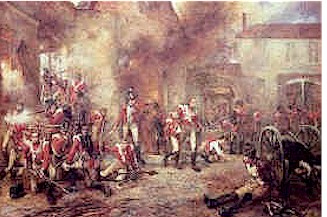 |
The battle of Waterloo began around 11.30 on Sunday, June 18th, with an opening cannonade and with an assault by Jerome Bonaparte's division upon the chateau of Hougoumont. The attack was intended to be merely a feint, the intention being to draw troops away from the Allied centre which was to be the real target for Napoleon. Jerome, however, threw more and more men into the attack until the fight for Hougoumont became almost a battle of its own within another battle, the Guards hanging on grimly throughout the day in the face on intense French pressure. The most dangerous moment for the defenders of Hougoumont came at around 12.30 when Jerome's men forced open the north gates of the chateau and were only forced out after a desperate piece of defending led by Lieutenant Colonel James Macdonnell, of the Coldstreams. The chateau would remain in British hands for the rest of the day, even as flames burnt most of its roofing following French artillery bombardment.
At about 1.30pm the second phase of the battle opened: Napoleon launched D'Erlon's corps against the Allied centre and left. The attack was preceded by a massive artillery bombardment from 80 guns of Napoleon's `grand battery'. The attack clearly demonstrated that the French had learned little from the Peninsular War as they came on in bulky, unwieldy columns. `They came on in the old style and were driven off in the old style,' Wellington remarked later, although at first D'Erlon was successful. Indeed, Bylandt's Belgian brigade broke and the steady volleys from both Pack's and Kempt's brigades could not halt the columns. The French reached the top of the ridge only to be met by Picton's division which burst through some hedges and unleashed a terrific volley into the massed ranks of muddy,blue-jacketed Frenchmen. The attack came shuddering to a halt in the face of a withering fire from Picton's men, most of whom were veterans of the Peninsula. Sir Thomas himself tragically met his fate; he was killed at the moment of triumph, for he fell dead from his horse with a musket ball through his forehead. He died as he had lived, cheering his men on, cursing them as usual as he had done so often in Spain and Portugal. An authopsy after the battle should show, that the Welsh General carried well hidden under his ragged civilian cloths another dreadful wound, which would have cost his life anyhow: Already at the engagement of the 17th June he had received a bullet in the chest and left the wound unattended to stand by his old chief against Bonny!
While Picton's men stepped over his dead body to press home their attack, Henry Paget Lord Uxbridge chose the moment to launch his cavalry against the disorganised French. D'Erlon's commanders desperately attempted to reorganise their Eagles but were suddenly swept away by an avalanche of heavy horses with shoe size of at least 5 and formed of Uxbridge's Union Brigade, consisting of the 1st (Royals), 2nd (Scots Greys) and the 6th (Enniskilling) Dragoons. Sir William Ponsonby‘s Scots Greys had seen no active service since 1795 but made up this absence with a vengeance as they smashed into the shocked ranks of terrified Frenchmen who surrendered in their thousands. During the charge Sergeant Ewart, of the Greys, captured the eagle of the French 45th Ligne, whilst on the brigade's right the Household Brigade charged, delivering an equally devastating attack against D'Erlon's battered columns. During its attack the Household Brigade also took an eagle. Unfortunately, the triumphant cavalrymen, the Union Brigade in particular, became carried away with their success and charged on despite the sounding of the recall. The Scots Greys charged right up to Napoleon's guns, slaughtering the gunners and spiking many guns with horseshoe nails they carried in little bags, but their horses were extremly exhausted and the Scotsmen suffered a severe mauling following a counter-attack by enemy cavalry, during which Major General Sir William Ponsonby, the brigade commander, was killed. He met in a certain sense the same fate, his father has met years ago in Egypt: Instead of taking his best horse, he had chosen a less precious animal for the fieldday; this hack, lacking strenght after the wild charge could not extract itself from a muddy place, allowing Napoleon‘s Polish Lancers to transperce Ponsonby by at least seven times before bringing him to the ground and finishing him off!
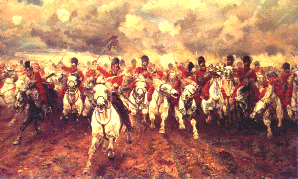 |
Charge of the Scots Greys
(Painting by Lady E.Butler)
Nevertheless, the attack had completely smashed D'Erlon's corps, some 3,000 Frenchmen being killed or wounded, while a further 3,000 were herded over the ridge towards Brussels as prisoners of war.
 |
At about 4pm Wellington ordered the Allied line to pull back one hundred paces to spare them as much as he could the frustrated mauling by continuous heavy French artillery bombardment. This order was perceived by Marshal Ney to be a withdrawal upon which he ordered a massive cavalry attack by up to 10,000 French cavalry who cantered up - charging was almost impossible over the muddy ground - time and time again to engulf the Allied infantry squares which stood steady on the reverse slope of the ridge. These attacks continued for about two hours and yet achieved nothing, mainly due to the fact that the cavalry were unsupported by infantry. In fact, the British infantry squares even welcomed these attacks as they gave them some release from the tortuous artillery bombardment that had tormented them them throughout the day and from the Peninsula they knew that as long as a square held firm there was little danger from cavallery, as horses would not jump into blades and the riders, armed with sabers never came into killing reach.
Even as Napoleon's cavalry thundered up the ridge of Mont St Jean the Emperor looked eastward in dismay as dark columns of troops began to appear on his right flank. They were von Bülow‘s Corps, the advanced force of Prince Blücher's Prussians. Napoleon despatched his Young Guard and Middle Guard to the village of Plancenoit where soon bitter and pitiless fighting raged between the two parties. The Prussians were full of hatred for what Napoleon had done to their country and to their dynasty and were decided to fight to the death. The village changed hands several times before Blucher's men finally held on to the place.
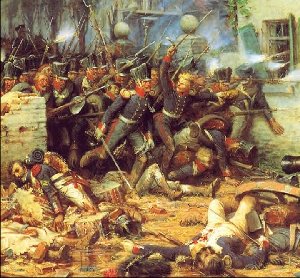 |
The Prussians fighting at Placenoit
In the centre of Wellington's position, meanwhile, one of the key crises of the day had occurred with Ney's capture of the farmhouse of La Haye Sainte. The defenders, the 2nd King's German Legion Light Battalion, had put up a magnificent resistance all day but when their ammunition finally ran out they were forced to abandon the place. Major Baring, the commanding officer, and barely forty men made it back to the main Allied position. The fall of La Haye Sainte enabled the
French gunners to bring their pieces to within just a few hundred yards of the centre of Wellington's line which reeled under the weight of this new danger and even Wellington's seasoned British troops found it difficult to remember anything worse happening to them in the Peninsula. The climax of the battle had finally arrived!
The effect that the fall of the farmhouse had on the Allied line was not lost on Napoleon who realised that now was the time to launch his Old Guard into the attack. It was now or never, for if he could not defeat Wellington before the Prussians made their presence felt then the consequences for him and his empire would be catastrophic. Peace with the Allies could only be signed on the Duke‘s death body!
Napoleon duly turned to his Old Guard, those faithful warriors who each had followed him for years as together they had marched to glory after glory. The Old Guard had yet to taste defeat and it was with great confidence that seven of their battalions, supported by guns, set out across the muddy fields, ploughed up by the earlier cavalry attacks. It is somewhat surprising that the Guard chose this dreadful route as it would, possibly, have been easier to march directly up the Brussels road and smash through Wellington's centre. However, Napoleon's veterans turned off the main road and headed for that part of the ridge held by Peregrine Maitland's Brigade of Guards. It is perhaps fitting that the decisive chapter of the final, great battle of the Napoleonic Wars should come down to a clash of arms between the finest troops that both Napoleon and Wellington could offer, the Old Guard and the 1st Foot Guards.
The Old Guard advanced slowly and to the beat of their drums across the muddy ground in giant squares, not wanting to taste what D'Erlon's troops had experienced earlier in the day. From ground level, of course, these dense squares gave the appearance of being columns and thus gave rise to the endless arguments as to just exactly what was the Old Guard's formation. As the French approached the ridge they separated into two, one body of troops heading for the 30th and 73rd Regiments and the other heading straight towards Maitland's Foot Guards.
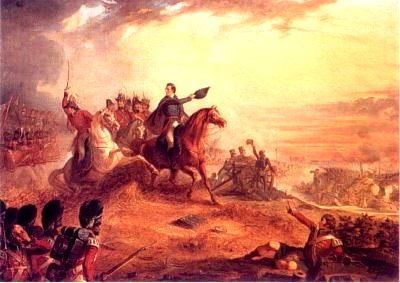 |
This attack was in many ways a repetition of so many of the French infantry attacks in the Peninsula. To the Old Guard the ridge looked deserted but just before it, lying in the corn, were two battalion's of the 1st Foot Guards and just at the moment when the French saw victory within their grasp Wellington shouted, `Now Maitland, now is your time!Up Guards, Make Ready, Fire!' All at once the Old Guard saw its path blocked by a long red barrier which seemed to spring up from nowhere. The French hardly had time to gather their wits about them before a series of devastating volleys tore them to pieces, sending them reeling and staggering backwards. The Foot Guards advanced to press home their attack, many of them `firing from the hip', so close was the range. As the Old Guard began to fall back Sir John Colborne's 52nd Light Infantry -highly experienced peinsula veterans under a cold-blodded superbe commander- wheeled round to pour more musketry into its shocked ranks, the enfilade fire of the Peninsular veterans finallybreaking the Frenchmen's resolve and sending them streaming away to the rear.
Napoleon was well forward, close to La Haye Sainte, when he saw his front collapse. He ordered his last batallions of the Old guard to form square across the main road, hoping to rally the troops behind them, but fleeing troops simply swept southward: Raked by musketfire and artillery three batallions of the Old Guard fell back on La Belle Alliance where their commander General Cambronne. called upon by the British to surrender, added to the legend of the Napoleonic Wars with the brief ( and I believe legendary !) reply "Merde!"
Chaos reigned over the battlefield. Most of the french were in full retreat. As night wore on, the Prussian pursuit rolled over more then 40.000 wounded, dying or dead men and about 10.000 dreadfully mutilated or killed horses.
At 9 o'clock that evening, Wellington and Blücker - the two victorious commanders - met at La Belle Alliance, surrounded by cheering soldiers, throwing their hats in the air, while a prussian band played " God Save the King" and "Nun danket alle Gott". The Battle of Waterloo was over and Napoleon‘s star had finally sunk into the seas of history. Wellington should remark: „ I hope to God that I have fought my last battle!" And his hope was to be fullfilled; the Sepoy General should never ever again draw his sword! He had conquered the Conqueror of the World and nevertheless the Duke left Waterloo a depressed and unhappy man; the slaughter had been so dreadful, so many lifes had been lost..................when looking on the original of the Waterloo Dispatch he wrote during the night and finished on the 19th of June, some clear spots are visible, spots where the tears of an invincible general have washed away the ink!
And to conclude with the words of Arthur himself: "I hope to God," he said," that I have fought my last battle: It is a bad thing to be always fighting. While in the thick of it, I am too much occupiedto feel anything; but it is wretched just after. Next to a battle lost, the greatest misery is a battle won!"
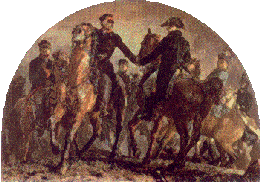 |
Wellington meets Blücher after the Battle of Waterloo

Watch for a chapter from my new novel " Die Ehre eines Soldaten" - "A Soldier's Honour" soon to come here.